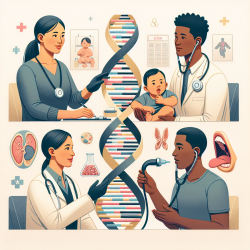As practitioners dedicated to the well-being of children, it's crucial to stay informed about the best practices for delivering sensitive diagnoses. A recent integrative review titled Evidence-based recommendations for delivering the diagnosis of X & Y chromosome multisomies in children, adolescents, and young adults provides valuable insights into this complex process. The review synthesizes a wide array of quantitative and qualitative literature, offering actionable recommendations for clinicians. This blog will outline these key recommendations to help you improve your practice and encourage further research.
Understanding SCM and Its Implications
Sex chromosome multisomies (SCM) are conditions characterized by one or more extra X or Y chromosomes. These include conditions like Klinefelter syndrome (47, XXY), Jacob syndrome (47, XYY), and Trisomy X (47, XXX). The diagnosis of SCM can have significant implications for a child's physical, neurocognitive, psychological, and social development. Therefore, delivering this diagnosis requires a thoughtful, evidence-based approach.
Key Recommendations for Delivering SCM Diagnoses
1. Parent Informational Needs
Parents and individuals receiving an SCM diagnosis value accurate, up-to-date information. Providing comprehensive resources about the condition can alleviate anxiety and help families navigate future healthcare needs. Recommended resources include:
2. Communication Strategies
Effective communication is paramount. Parents have reported that receiving the diagnosis from providers who lack a genetics background often leads to misinformation and increased stress. Ensure that the diagnosis is delivered in a positive, supportive manner, emphasizing the strengths and potential of the child.
3. Post-Diagnosis Support and Adaptation
Parents and individuals frequently need support in managing healthcare and non-medical symptoms related to SCM. Providing referrals to specialists such as genetic counselors, endocrinologists, and neuropsychologists can be invaluable. A multidisciplinary approach ensures comprehensive care.
4. Timing of Diagnosis
The timing of the diagnosis can significantly impact parental and individual responses. Prenatal diagnoses often result in higher anxiety levels, while postnatal diagnoses can bring relief by explaining previously observed symptoms. Tailor your approach based on the timing and context of the diagnosis.
5. Disclosing the Diagnosis to the Child and Community
Deciding when and how to disclose the diagnosis to the child and community requires sensitivity and consideration of the child's cognitive and emotional development. Parents often prefer to inform their child during peri-pubertal development when they are more capable of understanding the implications.
Conclusion
Delivering an SCM diagnosis is a critical moment that can significantly influence how families perceive and adapt to the condition. By focusing on parental informational needs, effective communication strategies, post-diagnosis support, and appropriate timing, practitioners can improve the overall experience for families. For a more in-depth understanding and additional recommendations, I encourage you to read the original research paper: Evidence-based recommendations for delivering the diagnosis of X & Y chromosome multisomies in children, adolescents, and young adults: an integrative review.










